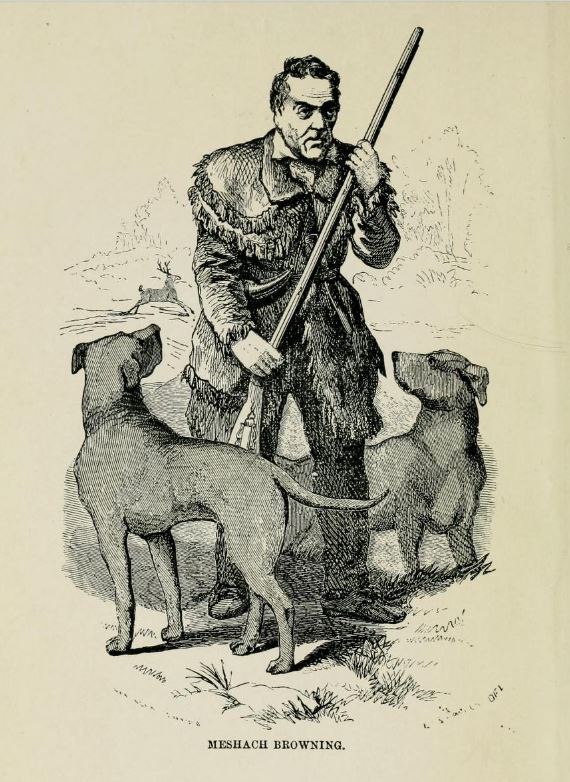“The country abounded with deer, bears, panthers, wolves, wildcats, catamounts, wild turkeys, foxes, rabbits, pheasants, partridges, wild bees, and in all the streams trout without number. The whole face of the country was like a beautiful sheet of wallpaper, variegated with all shades of color.” Forty –four Years of the Life of a Hunter, Meshach Browning
When thinking of great pioneer men, names like Davey Crockett and Daniel Boone easily spring to mind. Equally important in the history of the American hunting and frontier experience is tale told by local legend Meshach Browning in Forty-four Years of the Life of a Hunter. Writing by candlelight with a turkey quill pen, Browning recorded the daily trials and tribulations of his hard-scrabble existence in the wilds of Western Maryland. During his hunting career he claims to have killed between three and four hundred bears, about fifty panthers, over two thousand deer and scores of wolves and wildcats.
His account reflects not only the determination of early settlers as they surmounted the difficulties of frontier life but also his great love for an area he called “the prettiest country in the world.”

Meshach Browning’s Early Life
Browning’s roots in the United States can be traced back to Captain John Browning, who arrived just fourteen years after the founding of the first permanent English settlement in the New World. Meshach’s grandfather, William, and father, Joshua, served under George Washington’s command in the 1755 expedition against Fort Duquesne. There they saw the defeat of General Edward Braddock. Meshach Browning was born in Frederick County, MD in 1781.
After the death of his father, he, his mother and his siblings moved west to be closer to his mother’s family. They settled near Flintstone in present day Allegany County. In 1791, he moved with his aunt and uncle to an area known as Blooming Rose, near what is now the town of Friendsville. They squatted on a farm that had once been the residence of and old hunter, Augustian Friend. There, Meshach developed his passion for hunting, going after small game such as groundhogs or raccoons.
After he married his childhood sweetheart, he took to the woods out of necessity as much as passion. They began their lives together without a single dollar. To support his growing family, he supplemented the food he raised on his farm with the meat he procured on his hunting trips. He was also able to easily trade animal furs, such as deerskin, for money or enough grain to last through a winter. His hunting gear included a flintrock rifle, powder horn, bullet pouch, hunting knife, flint and steel for building fires and a tomahawk. His dress made him look every bit what we imagine a mountain man to be: coonskin cap, homemade moccasins and clothes made from homespun, home grown wool.
Hunting in Garrett County
Meshach Browning’s book recounts numerous tales of hunting excursions. He frequently spent a week or more alone in the woods away from his home and family. Ingenuity was key to survival for early pioneer hunters in Garrett County. Rattlesnakes were highly prevalent in the area at that time. To protect himself he twisted hay, or long grass, into ropes and then wrapped his legs up to the knee. In one unforgettable story he recalls killing a large buck with a knife as the wild waters of the Youghiogheny raged around them. He nearly lost his life after a savage wrestling match with the animal. The largest turkey he ever killed weighed twenty-six pounds without its feathers. In 1797, he killed an eleven foot panther, an animal he found to be “a most dastardly coward.”
To entice bears he would “roast the leg of a deer, and while the meat was roasting, rub honey over it, so that it would smell strong of the latter. Then I would cut off pieces, tie them under my moccasins, walk through the grounds the bears frequented, and return to the trap; when every bear which smelled my tracks would follow the trail to the trap, and generally get caught.”
Final Thoughts
Written in the fall and winter of 1858-59, his autobiography gives voice to the many men and women that left “civilization” in the east to embark on an adventure in Maryland’s western frontier. Many of the place names remain the same today, sparking the reader’s imagination as to how untamed Garrett County was and what it took to survive here. Many original artifacts from Browning’s life, including his bear trap, powder horn and leather belt, now reside in the Garrett County Museum in Oakland. His flintrock rifle is currently on display at the Smithsonian Museum.





